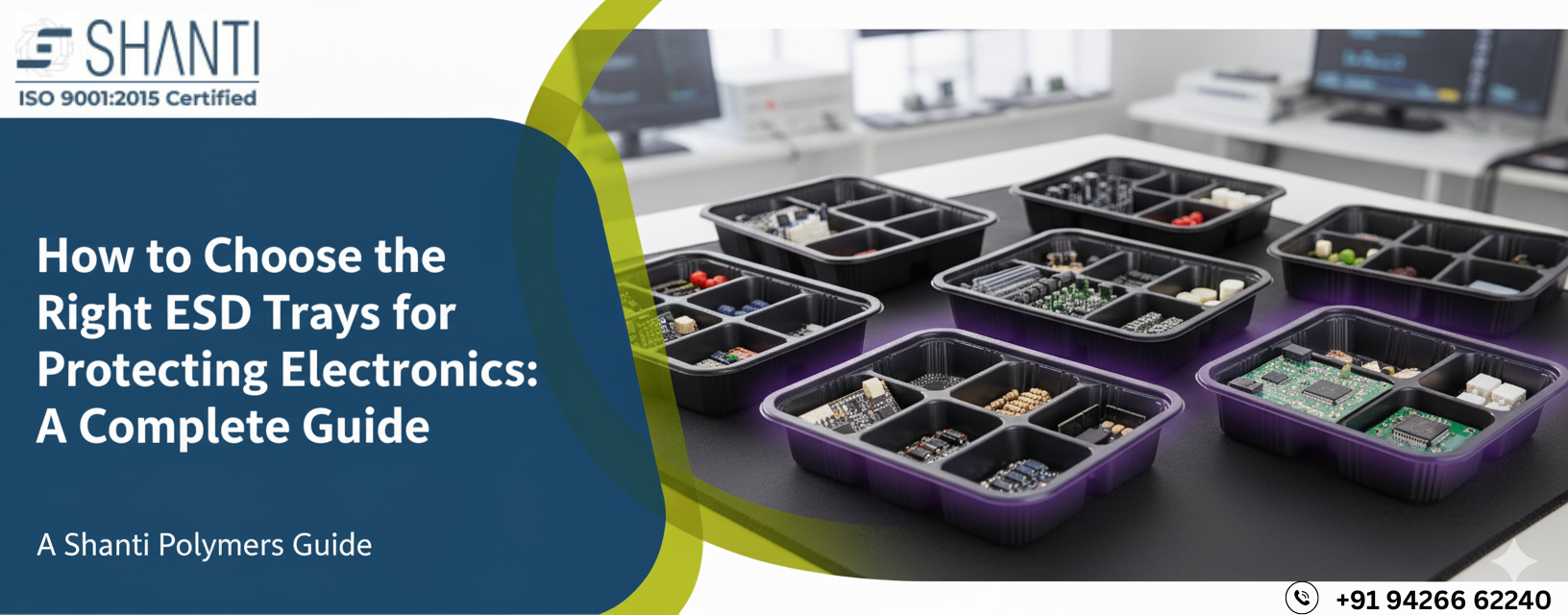
In the fast-evolving world of electronics, ensuring the safety and integrity of sensitive components is crucial. Electrostatic Discharge (ESD) can cause irreparable damage to electronic devices, leading to costly repairs or product failures. One effective way to protect electronics from such damage is through the use of ESD Trays. In this blog, we will explore how to choose the right ESD trays, the benefits they offer, and why they are an essential investment for businesses handling electronic components.

What Are ESD Trays?
ESD trays are specially designed storage and handling trays made from conductive or anti-static materials. These trays help in preventing Electrostatic Discharge, which occurs when there is an imbalance between static charges in an electronic component and its surrounding environment. By providing a controlled, static-free environment, ESD trays ensure the safety of delicate components during manufacturing, assembly, storage, or transportation.
Focus Keyword: ESD Trays in India
Why Are ESD Trays Important?
Electrostatic Discharge can cause permanent damage to integrated circuits, microchips, and other electronic components. A simple static spark can render a device non-functional, resulting in financial loss. Here’s why ESD Trays in India are essential:
- Prevents Damage from Static Electricity
ESD trays provide an electrostatic-safe environment for sensitive components, ensuring that static electricity doesn’t discharge and cause irreversible damage. - Reduces Costs and Waste
By protecting electronics from ESD, businesses can reduce costly repairs and avoid product waste due to damage during handling or storage. - Increases Efficiency
ESD trays improve workflow efficiency by organizing and protecting components, making it easier to store, transport, and assemble electronic products.
How to Choose the Right ESD Trays
Choosing the right ESD tray is crucial for ensuring the proper protection of electronic components.
- Material Type
The material of the ESD tray is one of the most important considerations. The most common materials used in ESD trays include:
- Conductive Materials: These materials help in dissipating the static charge to the ground. They are ideal for preventing any buildup of static charge.
- Anti-static Materials: These materials are less conductive but still prevent the buildup of static electricity by making sure the component is not charged.
Depending on the level of protection required and the type of components, choose between conductive and anti-static materials. Conductive trays are best for high-risk applications, while anti-static trays suffice for less sensitive components.
- Tray Design and Size
ESD trays come in various designs, each suited for different types of components. Consider the following:
- Compartments: Choose trays with well-defined compartments that ensure secure placement of small, delicate components.
- Custom Sizes: Ensure that the tray can fit the components you intend to protect. For larger components, opt for bigger trays with more space, while smaller components need trays with compact, snug compartments.
- Stackability: For efficient storage, select stackable ESD trays that can be easily organized in a controlled environment.
- Durability and Load Capacity
ESD trays need to withstand daily use in a high-demand environment. Look for trays made from durable, high-quality materials that can handle the weight of the components. Consider the load capacity and ensure that the trays are robust enough to carry the necessary load without damage.
- Anti-Slip Features
For added security, look for ESD trays that have anti-slip features. These features prevent the tray from sliding during transportation or storage, ensuring that sensitive components remain in place.
- Compliance with Standards
When selecting ESD Trays in India, ensure they meet international standards for ESD protection, such as the ANSI/ESD S20.20 standard. These standards define the criteria for handling electrostatic-sensitive devices and ensure that the trays provide adequate protection.
Benefits of Using ESD Trays
- Enhanced Protection
ESD trays prevent electrostatic damage, ensuring that your electronics stay safe during production, assembly, or storage. - Organization and Efficiency
ESD trays help in organizing electronic components, reducing clutter and improving the efficiency of your production line. - Cost-Effective Solution
By investing in ESD trays, businesses can prevent costly damage to sensitive electronic components, leading to long-term savings. - Durable and Reliable
High-quality ESD trays are designed to last, providing long-term protection without needing frequent replacements.
Where to Buy ESD Trays in India
When it comes to purchasing ESD Trays in India, look for reliable suppliers that offer high-quality products. Choose a supplier that provides various designs, sizes, and materials to suit your specific needs. Reputable suppliers like Shanti Polymers specialize in high-quality ESD trays that comply with international standards. They offer products that cater to industries ranging from consumer electronics to manufacturing and assembly.
Shanti Polymers’ ESD trays are designed to offer superior protection for electronic components, ensuring a static-free environment in every stage of production and storage.
Conclusion
Choosing the right ESD Trays in India is crucial for protecting sensitive electronic components from electrostatic discharge. By considering factors such as material type, size, tray design, and durability, businesses can ensure they are providing the best possible protection for their products. Whether you’re in manufacturing, assembly, or storage, ESD trays are an indispensable part of any electronics operation.
